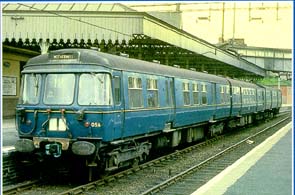 303056
303056

303 History History of the 303's
The class 303 multiple units were built between 1959 and 1960 by Pressed Steel from Elderslie to operate on the newly Electrified lines from Balloch, Helensburgh Central and Milngavie to Springburn, Bridgeton Central and Airdrie. Originally 35 sets were ordered, but this was soon changed to 91 sets all in when another 56 sets were ordered in 1960. The decision to order more sets was taken when it was announced that electrification was also to take place on the Glasgow Central - Cathcart Circle/ Newton/ Neilston/ Motherwell line. This electrified equipment was to become operational in 1962. The class 303's were 3 car sets containing 2 driving trailers at either end and the motor coach housing all the electrical equipment and the guards van in the centre. The driving trailers had coupling connections on the outer ends to allow 2 sets to work in 6 car formation at busier times.
 303056
303056
Originally the sets were allocated 001 - 056 on the Northside and 057 - 091 on the south side of the clyde. Thiss brought problems if a number of units from either the north or the south side were out of service and soon a common user approach had to be adopted. The other problem which wasnt solved until 1979 was that there was no electrification between the North and South Side systems meaning that both were operating on totally independent systems so the North Side units had to be dragged by either a Diesel or Steam engine from the Depot at Hyndland to the depot at Shields and vice versa.
Another key feature was the installation of electrical equipment which allowed the units to operate at either 6.25kv in the city centre areas (due to bridge clearances) or 25Kv in the outlying areas. This was eventually to become obsolete during the 1970's.
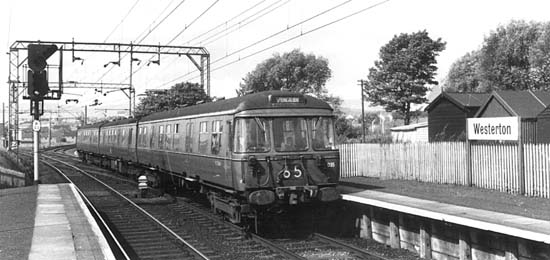 303035
copyright of the Railway Centre.com
303035
copyright of the Railway Centre.com
When the class 303s were introduced the passenger numbers increased dramatically because they were clean, bright, modern, fast and were totally different from the dirty steam engines they replaced. They also had a forward view from the cab ends as well allowing passengers the same view as the driver. The introduction of the 303s also had the added advantage of the atmosphere in the underground and partly open stations becoming less smoky, cleaner and more pleasant. Faster acceleration and higher speeds allowed for quicker journey times and a faster way of getting to work in and out of the city.
However soon after their introduction to service in 1960, they had to be withdrawn from service for approximately a year following an explosion in the motor coach of set 051 at Renton and an electrical fire in another set at Easterhouse the same week. The motor coaches had to be sent to England for modifications meaning the steam engines and coaches, most of which had been sent to the scrap yard had to be recalled, repaired and brought back into service within a very short time span.
In 1961 the units made a return following tests and modifications in England.
During the first few years, many modifications were made to the units such as strengthening the entrance vestuble floors as stillitoe heels were causing damage. However the most notable change was made to set 035 which received Peters doors, (they opened out and slid along the body side just like the class 334's do today) and thrystor controls in 1967. Diagrams were rostered early on to allow 19 sets to be out of traffic for repairs and modifications at a time, however this was seen as a waste of resources and in the 1980s surplus units were sent to England.
1967 saw the the introduction of the 19 class 311's, these were similar to the class 303s except they had an extra grille next to the guards van in the motor coach, had flourecent lighting throughout, were built by Cravens and they were only 25Kv units (not like the 303s as seen earlier). These units were built to operate on the Gourock and Wymess Bay Lines, but later saw use on the other lines. 1967 also saw the 303's first Livery change, The units were repainted from Caledonian Blue to Br Blue.
 311103
picture by RailwayCentre.com
311103
picture by RailwayCentre.com
In August 1973 303091 was severely damaged following a collision with an Ayr DMU outside Glasgow Central. The unit was rebuilt in and returned to service in 1977 and was noticable by having different cab control desks from the rest of the fleet. In 1974 set 303074 was not quite so lucky, following a crash, again with an Ayr DMU, this time at Paisley Gilmour St, the damaged vehicles were scrapped and the set later disbanded.
1974 saw the Electrification of the West Coast Main Line, the Lanark Branch and the Hamilton Circle allowing the introduction of the Blue trains to the Hamilton Circle, Lanark and Carstairs.
1974 also saw further accidents, 303007 was involved in a collision with a cement train at Rutherglen resulting in severe damage to the unit which saw one trailer surviving whilst the other 2 vehicles were scrapped. 303022 also surrered crash damage when it hit the buffers at Lanark.
1979 saw the reopening of the low level line from Rutherglen to Partick. This move allowed Motherwell, Hamilton Circle and Lanark services to be diverted along this new line called the Argyle Line. This move saw Motherwell and Hamilton services terminating at Dalmuir whilst Lanark services Terminated at Milngavie on the North side of Glasgow. At last, the north and south lines were joined up.
The 1970s also saw the replacing of the curved windscreens with flat toughened glass after a driver was killed by an object thrown from the lineside.
1980 saw the first full unit being scrapped when 303002 was withdrawn with cracked underframes after the set ran away from Neilston Station and presumably crashed.
Unique set 303035 was withdrawn as being non standard and less reliable than the other units. The motor coach was scrapped whilst both trailers were given standard fittings and saw use on other units in later years.
In 1983 some sets, which were deemed as being surplus were transferred to Manchester to operate on their services. They were painted in the Greater Manchester PTE livery of Orange and Brown and operated the Crewe services. The units were not as well maintained in Manchester and soon became unreliable and unpopular with crews and passengers. However some sets even made it down to London on some services.
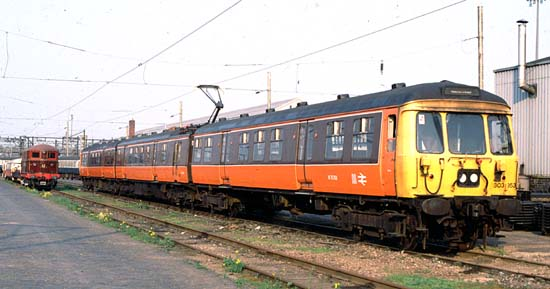 303060 at
Longsight copyright railway centre.com
303060 at
Longsight copyright railway centre.com
303036, 041, 048, 049, 050, 053, 057, 059, 060, 066, 067, 078, 082 were the units sent to Manchester. These units would remain here until 1993 although most were withdrawn long before this. There was three exceptions, set 048 was sent back north in 1990 for restoration back to its origianl style, where as 060 and 082 were used for spare parts before being scrapped. 048 being was the last unit to remain in service unrefurbished and lasted until 1998 until it was scrapped. 303059 didnt last long at Manchester, shortly after arriving there the transformer in a class 506 unit, stabled next to it exploded and severely damaged 303059 resulting in the unit being scrapped.
In the 1980s 50 303s were refurbished and emerged wearing the Strathclyde Orange and Black livery and refurbished interior, new seats and new lights. New Windows and gangways between the carriges were fitted later. However units 303055,056 and 085 retained their sliding windows to the end. New high intensity headlights were fitted in place of the headcode box on the front end.
As part of the refurbishment program, the 303's required the removal of deadly asbestos, withdrawn units 017 and 022 were used as asbestos storage vehicles for a time during the program.
The sets to receive this treatment were:
303001,3-4,6,8-14,16,19-21,23-25,27-28,32-34,37-38,40,43,45-47,51,54-58,61,65,
70-71,77,79-80,83,85,87-91.
After being towed back to depot following refurbishmentin the 1980's, 303051 and 303090 ran away from Yoker Depot and crashed into the loco 37011 which had been towing the unit to Yoker, further down the line, resulting in the withdrawal of unit 051. One trailer car from that set was later reused in set 033.
In 1988 303033 became the first 303 to be formed from 3 vehicles from 3 seperate units.
In 1989 303005 and 303071 were involved in a fatal head on collision at Bellgrove causing severe damage to both trains and led to the scrapping of all of set 005 and a trailer and motor coach of 071. In 1990 303037 and 314203 were involved in yet another fatal crash at Newton. Both units were reformed with 303037 being reformed from 071's spare trailer and the motor coach was swapped for that of set 028 which ran with 037's original motor coach.
In 1990 following the introduction of the class 320s the the North Clyde lines the remaining unrefurbished class 303s except for 303048 and all the class 311s were withdrawn from service.
1991 saw the return to service of set 048 in original 1960's livery and
interior. The unit was to be used for special events and for driver training.
This year also saw 303038 being scrapped following a fire which gutted the
entire unit. This happened because it was left stabled at Shields with its panto
up. Following this, a rule was enforced by BR that a class 303 could not be left
unnaccompanied for more than 15 minutes with its pantograph up. Set 303049 was
sent to Clacton to see use as a sandite vehicle and was painted in Network
South East Livery and renumbered 303999. Class 311's 311103 and 104 were used as sandite trains
in the Glasgow area, being renumbered 936103 and 104. 
1994 saw the Fatal Derailment of 303046 on the Wymess Bay Branch following an object being placed on the track by vandals. The vandals were later caught and received life in jail and 303046 was scrapped.
Following the discovery of deadly asbestos in set 048, the unit was withdrawn.

In 1997 4 units (303019,21,23,87) were repainted into the new SPT Carmine and cream livery, but shortly after their return to traffic, all major overhauls and repaints were stopped following the announcement that new trains (334s), were being built to replace the 303s and would be in service for 1999.
1998 saw the scrapping of withdrawn set 048 which had been vandalised following its withdrawal from service.
In 1999 following a number of problems, the 334s were not yet ready for introduction so the 303s continued in service and a reshuffle saw the 303's becoming the only multiple units to operating on the Argyle line services with the class 314's moving to the Cathcart Circle. Spare 303s were still being used on the other lines to cover failures and shortages of stock and indeed the North Clyde lines still had a few 303 operated diagrams, the Cathcart Circle, Gourock and Wymess Bay lines had regular 303 operation especially at peak times. Less common was the use of 303s on the Ayrshire services as they were dominated by 318's.
In 1999 there were still 43 units in service, these were
303001,3,4,6,8-14,16,19-21,23-25,27-28,32-34,37,43,45,47,54,56,58,65,70,77,79,80,83,85,87-91
Into 2000 and still no sign of the 334s being ready. This was further delayed when 334001 which was stabled at Platform 11a, ran away from Central Station and derailed on the Catch Points.
2000 was another eventful year for the 303's, 7 withdrawals took place in this year, sets 024, 028 and 089 were withdrawn early on in the year. 025 and 056 were withdrawn prematurely following arson attacks which destroyed the whole of 025 and all but one driving trailer from 056 was destroyed. 303058 was scrapped after the motor coach exploded at Blantyre station whilst operating a service to Coatbridge Central, whilst 303010 was withdrawn after its motor coach caught fire at Bishopton in December.
The withdrawal of 056 allowed a strange looking hybrid unit formed of 056's remaining driving trailer, complete with original sliding windows becoming part of set 303043 bing joined with 303043's motor coach and remaining driving trailer (which both had hopper windows) gave the set a rather strange look which it would retain until scrapping.
Units 303001,3,4,6,8,9,10,11,12,13,14,16,19,20,21,23,27,32,33,34,37,43,45,47,54 ,65,70,77,79,80,83,85,87,88,90,91 were the 36 remaining units at the end of the year.
2001 was really the beginning of the end of the class as the 334s started to appear on the Ayrshire routes, the 318s started cascading onto the Argyle line, which at that time was exclusively run by 303s. From October that year there were enough 334's in service to allow the 303's to be confined to the Argyle and North Electric services and the class started to dwindle in numbers.
11 sets were withdrawn that year were 303013,14,23,34,43,47,65,70,80, 87 and 88 with 10,14,55,58,61,89 going to scrap.
This left 1,3,4,6,8,9,11,12,16,19,20,21,27,32,33,37,45,54,77,79,83,85, 90 and 91 as the 24 units in service.
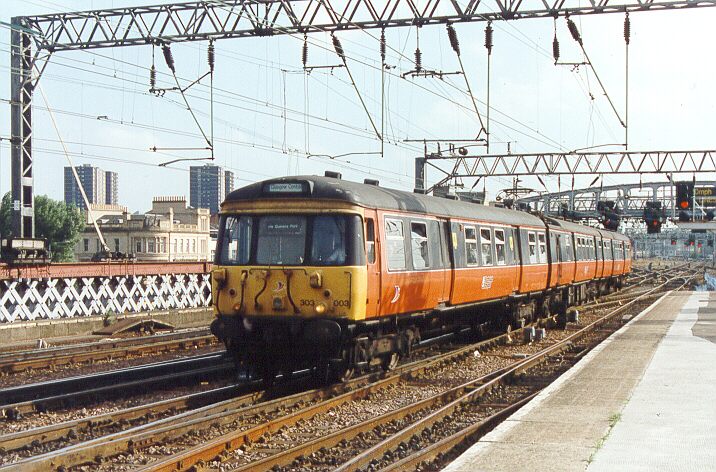 Copyright
Ross Aitken
Copyright
Ross Aitken
Early in 2002 4 more 303s were withdrawn and sent for scrap, units 8, 12, 16 and 77 went (at least 3 of these units were still in service 2 days prior to going) temporarily reducing the numbers in service to 20, however in February 2002 303023,43 and 88 were reinstated and it was announced that only 23 sets were required to operate 16 diagrams these were
:303001,3,4,6,9,11,19,20,21,23,27,32,33,37,43,45,54,79,83,85,88,90,91. Next
303013, 19, 34 were sent for scrap.
March 2002 saw set 054's motor coach catch fire at Bellshill on a late evening Lanark - Milngavie service and the set was withdrawn. Set 033 was also withdrawn around the same time reducing the numbers down to 21. June/July 2002 saw the withdrawal of 10 sets, these were 6,20,21,23,32, 33,37,79,85 and 91 reducing the numbers to 11 sets.
Sets 6,21,23,33,37,54,65,70,79,80,85,91 were all sent for scrap whilst 303032 was withdrawn for preservation,
August 2002 saw the withdrawal of 303009 after the motor coach caught fire at Springburn. 303027 was withdrawn soon after with electrical and motor faults. At this time sets 303001,3,4,11,43,45,83,88,90 were still in service. Into late October and sets 45,83 and 90 were withdrawn. In December 303020, 027 and 045 were taken to Immingham and in the end 303001, 3, 4, 11, 43 and 88 remained till the last day where 011 and 088 worked the last ever journey by a class 303 to Helensburgh on 30th December 2002.
My Last journey on a 303 was on 20th December 2002 in 303003 on the 8:20 Motherwell - Dalmuir service. My last sighting of a 303 in service was 303011 and 088 on a Dalmuir - Lanark service on the 28th December.
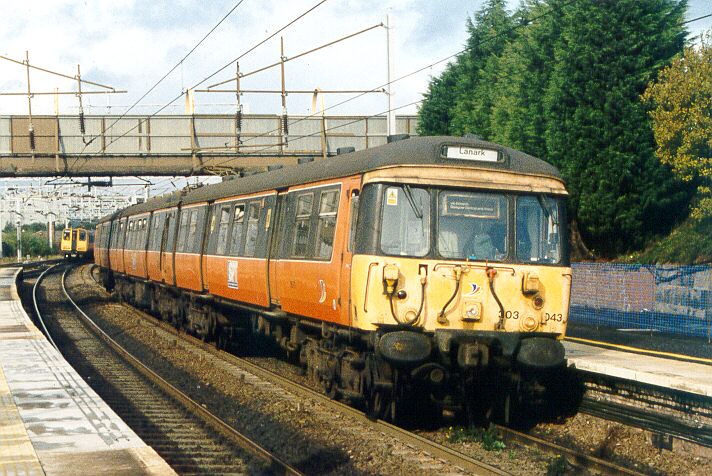 Copyright
Ross Aitken
Copyright
Ross Aitken
Following the withdrawal of the last 303s 003,090 and 083 were coupled together and 043,011 and 088 were coupled together waiting removal to Immingham and for a few weeks 001 and 004 were used as depot shunters at Shields. On the 13th of January 003,083,090 were taken to Immingham. A trailer from 040 was spotted on a lorry on the M74 during that week. On 20th January the remaining sets, 001,004,009,011 and 043 were removed to Immingham by rail. 303088 , which was supposed to go along with 011 and 043, made a late attempt to stay when its brakes siezed and it developed a wheel flat. 303088 was dumped in Bridgeton Yard and was later moved to Shields Depot, where it remained for a couple of months. 303088 was uncoupled and split into 3 parts awaiting removal to Immingham by Road. vehicle 75613 of set 303013 which was thought to have been scrapped, has been saved for use at a police training centre at Gravesend, meaning another 303 vehicle is still in existance.
 Copyright
Ross Aitken
Copyright
Ross Aitken
March 2003 finally saw the Departure of the last 303 in Scotland. 303088 (as you will already have read had made a bid for safety by jamming on its brakes when been taken to Immingham), was finally removed by road to Immingham for scrapping. Its a pity Scotrail didnt take the chance to restore it for use at special events. The trailers from 303088 have been taken away to Immingham by road and the motor coach from 088 was being stripped for spares at Shields for set 303032. 088's motor coach was finally removed and taken by lorry to Immingham for scrapping. 303032 was soon returned to Boness for preservation. Both trailers are 303032s originals with the motor coach being 61503 from 303023 after 61502 from 303032 was damaged at Immingham.
I think its fair to say that there will never be multiple units as good as them and that their modern equivelants 318,334's can, and will never be a match for them and probably wont last as long as the 303s did. I suppose we can be thankful that we got an extra 3 years out of the 303s.
303 facts
*The 303s are numbered 303001-303091*
*They were originally known as AM3*
*They were introduced in 1960*
*They were built by Pressed Steel*
*vehicle numbers: DTS - 75566-75600, 75746-75801
MBS - 61481-61515
61812-61867
BDTS - 75601-75635 75802-75857*
*They are 200ft long*
*They have 160 seats*
*They have corridors between vehicles*
*The maximum speed is 75mph*